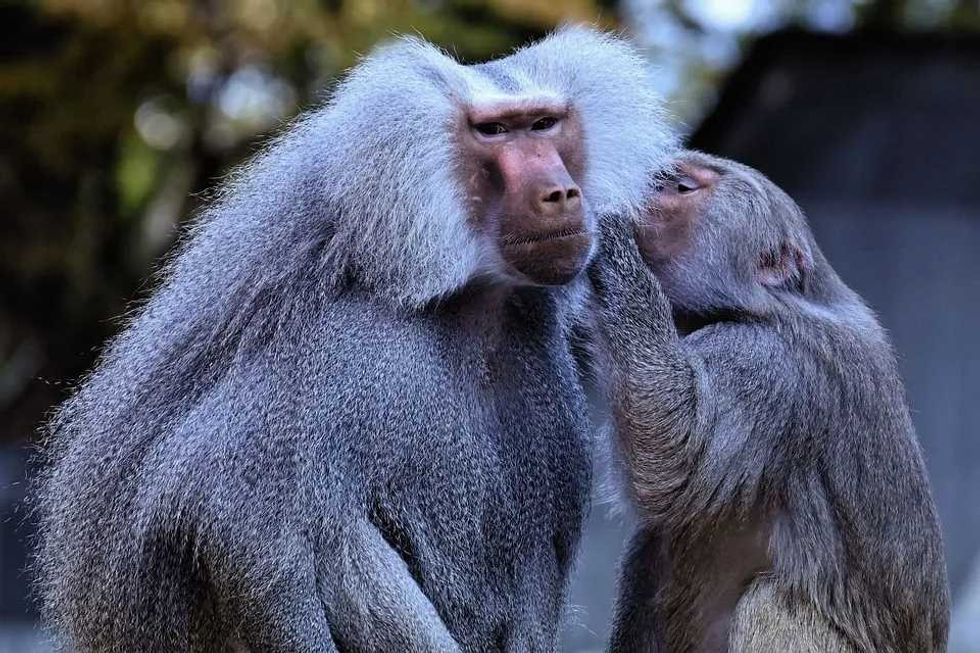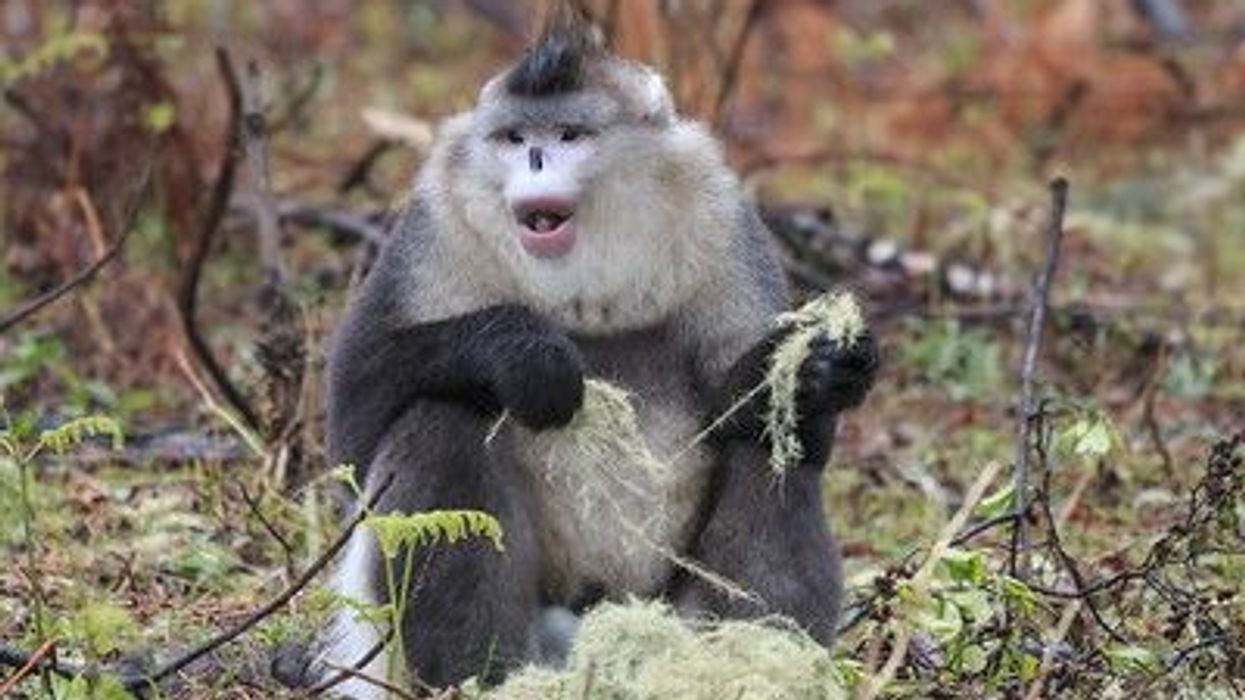Baboons, considered the world's largest monkeys, are primates belonging to the family of old world monkeys. They are only found in specific locations like Africa and the Arabian Peninsula.
They require semi-arid conditions to survive and consume plants and animals both. They can be hunted down by leopards and cheetahs as well as humans.
Though they have been listed as not extinct, their population is decreasing due to reasons like baboon hunting, habitat loss, overgrazing of cattle, unavailability of food, and extreme weather conditions. Baboons are also consumed as meat by humans.
There are mainly five species of baboons found in the wild, namely, hamadryas baboons (Papio hamadryas), chacma baboon (Papio ursinus), a guinea baboon, yellow baboon, and olive baboon (Papio anubis). Huge populations of the olive baboon are found everywhere in Africa.
The smallest baboon among this lot is the guinea baboon.
So here are some interesting baboon monkey facts, hamadryas baboon facts, gelada baboon facts, olive baboon facts, along with chacma baboon facts. After reading about different baboon species, you may also look at pygmy marmoset facts and eastern lowland gorilla facts.
Baboon Interesting Facts
What type of animal is a baboon?
Baboon is a primate that belongs to the family cercopithecidae. Baboons are known to be the largest monkeys, and their genus has five different species. Their population is limited to Africa and Arabia.
What class of animal does a baboon belong to?
A baboon is a mammal that can weigh anywhere between 30-80 pounds, depending upon its species. They are omnivores that can eat both plant material as well as feed on rodents, juveniles, and small mammals. They are intelligent and said to have the IQ of a three-year-old toddler.
How many baboons are there in the world?
The populations of the olive baboon, chacma baboon, hamadryas baboon, and yellow baboon are of the least concern, while the troop of guinea baboon are near threatened. Their populations are divided into five species by the name of papio hamadryas, papio papio, papio anubis, papio cynocephalus, papio ursinus.
Where does a baboon live?
The woods, tropical rainforest, and savanna is where you will find a baboon inhabiting its group, including males, females, and their many offspring. All primates are very social animals and live with 5o-250 members forming a troop.
The troop can thrive in semi-arid conditions and can adapt to an environment that is similar to a forest. The troop requires tall trees for sleeping during the night but spend most of their time on the ground. The entire troop is both arboreal as well as terrestrial in nature.
What is a baboon's habitat?
A Papio anubis habitat can be a tropical forest with tall trees, bushlands where the temperature is moderate, and savannas. The environment in which they live should have a water resource as well as shrubs and plants for them to feed. They cannot survive in a completely arid environment but can thrive in semi-arid locations like Africa and Arabia.
Who do baboons live with?
Like all primates, baboons live with their own species, also known as troops which are hierarchical. They sleep on tall trees and also climb on the tops to look out for danger. The troop of a baboon consists of males, females, and offspring. They stay in groups while on the ground for protection against wild predators.
How long does a baboon live?
The life expectancy of a baboon in their natural environment is 20-30 years.
The lifespan of a baboon is different for different species. The guinea baboon can live for 35-45 years in the wild, while the yellow baboons have a shorter lifespan of 13-15 years, but the female yellow baboons have set a record of surviving till the age of 27 years.
The chacma baboon also can live up to 30-40 years, while the life expectancy of the hamadryas baboon is 30 years and that of the chacma baboon is 20 years, respectively.
How do they reproduce?
Baboons are polygamous in nature and continue mating all around the year with different partners. During the mating season, the male baboon protects the female baboon from other males which often leads to a fight and biting.
The female baboon is sexually active only during its cyclical estrus which can last for 30-40 days. TBaboons reproduce during this time span, and after a gestation period of 180 days, the female gives birth to a single offspring.
What is their conservation status?
The conservation status of baboons is of the least concern but the population of the guinea baboon is listed as near threatened. Even though these old world monkeys/primates are far from extinction, their population is decreasing day by day due to reasons like habitat loss, predation, and unavailability of food or water resources which can result in poor nutrition.
Baboon Fun Facts
What do baboons look like?
A baboon is 20-40 in long and does not have a prehensile tail like other primates. It cannot use its tail to grip or hold things. A hairless baboon with red bottoms indicates its readiness for sexual reproduction.
The baboon’s fur is mostly yellow-brown or golden brown in color. They can be easily identified as their face has locks of hair located on either side. If you look at a baboon face, you will find that it has tufts of hair on either side.
How do they communicate?
Baboons are social primates and can communicate through their body language or by using vocalization. Body posture, gestures, and facial expressions can all indicate a message while the baboon is communicating.
The most common facial expression in a baboon is when it opens its mouth wide open and bares its teeth which can be considered a threat. Baboons use grunting noises throughout the day, while adult baboons use calls for communication.
How big is a baboon?
A baboon’s size may vary according to its species. There are five species of baboons found in Africa and Arabia called the yellow, chacma, olive, hamadryas, and guinea.
The hamadryas baboon is 16-18 in long and has a bodyweight of 44-66 lb. The bodyweight of a female hamadryas baboon is 22-33 lb. The body length of an olive baboon is 20-44 in, while their body weight is 33-60 lb.
How fast can a baboon move?
The baboon can move at a speed of 30 miles per hour. They are very agile and climb treetops during the night to sleep or to escape a predator.
The walking speed of a baboon declines as it gets older, but mature male and female baboons along with their infants, are active and spend their time on the ground during the day.
How much does a baboon weigh?
The weight of a baboon differs according to its species. The weight of a male hamadryas baboon is 44-66 lb while that of a female is 20-33 lb.
Olive baboons can weigh anywhere between 33-82 lb. The female chacma baboons have a higher body mass compared to the males and can weigh 30 lb, while the males only weigh 22 lb. The weight of a yellow baboon (P. cynocephalus) can range from 24-50 lb.
What are their male and female names of the species?
There are no specific names for male and female baboons. They are known as a male baboon and female baboon respectively.
What would you call a baby baboon?
There is no scientific name for a baby baboon. These old world monkeys can simply be referred to as baby baboons or juvenile baboons.
What do they eat?
Baboons take an omnivorous diet and have sharp canine teeth which can kill small mammals instantaneously with just a single bite. They are crop-raiders and baboon diet includes plants, roots, seeds, nuts, along with young antelopes, rodents, and sheep. They can adapt to an environment that has abundant food and water resources.
Are they dangerous?
Even though humans are a great threat to baboons, baboons, on the other hand, have only threatened or intimidated humans. There have not been any cases of a baboon attacking human beings, but if they come across a human being, they might bare their sharp teeth to protect themselves and scare the humans away.
Would they make a good pet?
No, baboons will not make good pets. They belong to the category of of old world monkeys and can cause destruction of the household if left alone.
They are very intelligent and would try to escape the house. They should better be left out in the wild where they can live their life to the fullest with their troop and get their preferred diet.
Did you know...
Baboons have loose cheeks for storing food that they consume to deposit after reaching a safe area. The baboon teeth are similar to that of a lion. They are sexually dimorphic, which means that male baboons have a higher body mass compared to female baboons.
A Mandrill baboon looks like a baboon, but is more related with cercocebus mangabeys.
The oldest fossil of this primate is the baboon skull which was found in South Africa and is said to be at least two million years old.
Baboons, being social animals, move in large troops and each troop can consist of ten to three hundred members, so that they are able to protect themselves.
Why are baboon's buttocks red?
The red buttocks in females are an indication that they are ovulating and are presently in their estrus cycle. This is also a sign that the female baboon is ready for reproduction and that the male baboons can approach her for copulation.
What are baboons afraid of?
Baboons are scared of both humans and animals. Predators like cheetahs, leopards, can easily kill the baboons, while humans also hunt down baboons for their skin and because they are common as a pest species.
How to draw a baboon?
Draw the round head of a baboon and draw its eyes, ears, and nose by referring to a sample picture. Draw its belly and legs, followed by the tail. Outline and highlight the eyes and other body parts wherever needed. Paint the body golden brown or yellow-brown in color with strokes of black.
Here at Kidadl, we have carefully created lots of interesting family-friendly animal facts for everyone to discover! Learn more about some other mammal including capuchin monkey, or mountain goat.
You can even occupy yourself at home by drawing one on our baboon coloring pages.










